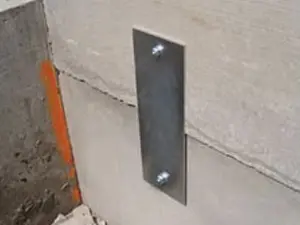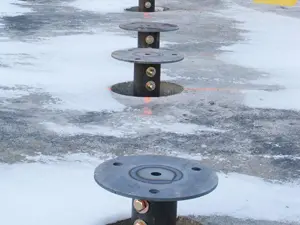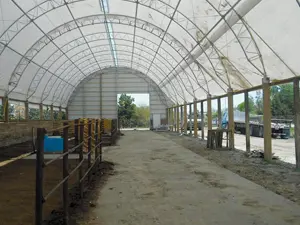Choosing The Right Building Foundation
During the design phase of a project, one of the primary tasks operations will need to accomplish is selecting their building foundation. A foundation is intended to distribute the weight of the structure, transferring loads from its frame or load-bearing walls to the ground below. This makes it crucial for operations to understand which type of foundation will be best-suited to their building, as well as the land on which it is built, so they know their space will remain structurally sound over time.
The first step in choosing the right building foundation is deciding on a location for the structure. Once the site has been chosen, businesses will then need to assess its soil conditions to make an accurate determination of its bearing capacity. This will help project managers narrow down all the foundation possibilities, allowing them to pinpoint the safest and most effective option.
Every foundation, whether temporary or permanent, comes with pros and cons that should be weighed carefully. After all relevant considerations with regards to soil capacity, construction timeline and cost are made, business owners will be confident enough to make an informed decision about the ideal building foundation for their needs.
Temporary Options
Pre-Cast Concrete
Although usually thought of as permanent, pre-cast concrete is actually a temporary foundation. Pre-cast concrete blocks are relatively inexpensive and can be purchased locally by operations. Dropping the blocks into place is easy and usually only takes one day to complete. ClearSpan’s durable steel block straps are recommended to secure the blocks together, which may add an extra day to installation.
When concrete blocks are no longer needed, operations can simply disassemble the building and remove and/or relocate the blocks to their new destination. Pre-cast concrete blocks are a popular choice for buildings that house salt or other commodities, because they help retain materials inside, while also withstanding heavy loads from the structure.
Blocks can protect the building from getting bumped into by people and vehicles as well. ClearSpan recommends pre-cast concrete blocks for building of 65 feet and narrower. In some cases, these concrete blocks can be engineered on smaller structures.

Helical Anchors
As one of the most popular foundation types amongst ClearSpan customers, helical anchors are reliable, economical and quick to install. Helical anchors are known as a pile foundation, which is a specific type of deep foundation, and work by drilling directly into the ground anywhere from eight to twelve feet deep.
Like other deep foundations, these pair well with larger structures and allow them to be erected on sites with soft or weak soil conditions. Deep foundations can also help structures avoid differential settlements, which more commonly impact shallow foundations. These occur when the soil underneath a building contracts, expands or shifts, potentially compromising its structural integrity.
ClearSpan’s Helical Anchoring System may be classified as temporary, but it is strong enough to remain permanent. The Helical Anchoring System requires no concrete and minimal excavation, which cuts down dramatically on expenses associated with foundation construction and site work. Helical anchors are exclusive to ClearSpan and are favored among moving jobsites.
Helical anchors are offered in-house and ClearSpan’s construction crew can complete installation in one to two days, depending on the type of building and its size. A geotechnical report on the soil that the anchors are going into must be supplied by operations. Businesses may employ helical anchors without engineering if their area allows it, but if rock is hit, they must find an alternative anchoring option.

Sign Up Now To Learn More
Driven Tube Anchor Kits
Driven tube anchor kits are used in ClearSpan truss buildings that measure sixty five feet wide and under. This unique system works like a tree’s roots, driving anchors in at varying angles to create a strong hold. Six feet, 1.66-inch OD (outside diameter) pipes secure plates to the ground and the building is then anchored on top.
Installation usually requires use of a jackhammer or post drivers, which can take an average of two to three days to complete. These temporary anchors can be self-installed by customers.
Shipping Containers
Buildings mounted on top of shipping containers generally require a box beam that connects the containers and provides a flat surface to mount the building onto. When it’s time to relocate, shipping containers can be moved to a new location and used again.
Customers find that shipping container foundations are easy to install and very effective at providing storage space and added height. It’s important to note that if the foundation is engineered, the containers need to be secured to the ground, which can be done effectively with helical anchors. Non-engineered buildings do not require containers to be secured to the ground.
See These Two Popular Building Foundations In Action
Permanent Options
Poured Concrete
Poured concrete slabs, walls and piers are a common type of shallow foundation, and are also permanent, so they tend to be one of the more time-consuming installation options. Shallow foundations sit closer to ground level than deep foundations and generally have more width than depth, making them a great choice for smaller and lighter buildings.
The curing process for poured concrete could take between twenty to thirty days, depending on the time of year that the concrete is poured. It’s best for operations to speak to a local concrete contractor to iron out timelines.
Concrete walls can be designed in a variety of useful styles, such as push walls, retainment walls or straight side walls for extra height. To avoid the need for drilling, customers can wet set their anchors during the pouring process. Wet setting is the act of sinking anchors into wet concrete as soon as it is poured, allowing the anchor to be adjusted as the concrete hardens.
Wood Posts
Popular in riding arenas, hay storage facilities and cattle housing, wood post foundations can be installed by customers in just a couple of days. They are generally found in smaller structures; more specifically, ones that are 65 feet in width and under.
Once the wood posts are in position, concrete is typically poured around them, which means there is a little wait time involved as part of the curing process. Although they cannot be engineered, wood posts are inexpensive and provide a decent amount of vertical side wall height.

I-Beam
An I-beam is a girder shaped like the letter “I.” I-beams require a pier poured into the ground with wet set anchors to hold them in place. Installation can take a few days, since the concrete must dry and set. I-beams are more rugged than wood posts, so they’re a great way to protect the building from potential damage.
Selecting the right building foundation, whether it involves building on top of an existing foundation or starting from scratch, can become a challenging task. Fortunately, ClearSpan’s wide selection of temporary and permanent foundation options gives business owners plenty of flexibility. Moreover, ClearSpan staffs experienced professionals who can help recommend, install and oversee construction of any metal or fabric building foundations.
To learn more about the different building foundation options, call or Request a Quote today.
This post was originally published in July, 2018 and has been updated for freshness, accuracy and comprehensiveness.
Related ARticles
4 Types Of Building Construction Materials You'll Encounter In Your Project
As a starting point, these are some of the building construction materials operations can expect to choose from when beginning their ClearSpan project.
Avoid These Big Mistakes In Commercial Building Design
With how many factors contribute to an effective commercial building design, a number of operations end up making errors that impact the quality of their structure.
How A Shipping Container Foundation Can Improve Your Operation
A fabric structure that’s paired with a shipping container foundation can provide businesses with a storage powerhouse, as well as a wide-open space and higher clearance for workers and vehicles.
Fabric Buildings Cost: What Impacts Fabric Building Prices?
Fabric building prices can be impacted by a wide variety of factors, from the design of the structure itself to the site it’s being built on.

